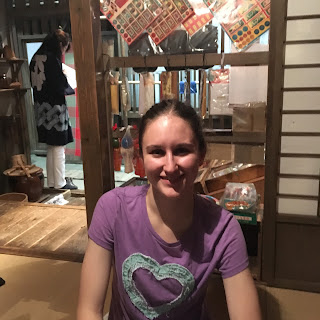When I got to Tokyo, I had pretty much no plan. I hadn't even tried to make a plan. So what I did was check into my hostel and then grab one of their guidebooks. Then I went looking for anything that looked older than America.
I have to say that I think Tokyo was the wrong city for that. The guide books are filled with shopping streets and amusement parks. But, anyway, I did find some historical sites, and, most importantly, some museums.
One of the first things I did in Tokyo was visit the Shitamachi Museum (shee-TA-ma-chi). This is a museum that shows different houses in Tokyo throughout the city's history. You get to see how the houses stayed the same, and how they were different.
Having had about 5 hours of sleep on the night bus, I wasn't especially alert for this, but I still remember some of it very well. Some of what really stuck out to me was that some parts of Japanese inside life really haven't changed.
Anyway, I highly recommend this museum. The displays are fascinating!
Pictures!
Most of these pictures are from the time of the Edo Period, so between
1603-1868. Edo was the first name of Tokyo.
First, the signs of fortune! This is the business area of a merchant's home. He had the cat there to bring him money in his business deals. The shield in the upper right-hand corner is also a way of bringing luck:
I remember the tour guide saying that the cat with one paw raised will bring lots of money, and the cat with the other paw raised will bring something else good. But, they never have cats with both paws raised, because that would be a symbol of surrender. If you know much about World War II, you know how the Japanese feel about surrendering.
Anyway, that was the merchant's room. I actually remember (but don't have a picture) that there were flags put out in front of his house when his store was open for business. Those flags are still used in Tokyo today!
After looking at the merchant's shop, we looked at the less well-to-do houses. First, we saw the well water and the oven:
This next picture really stuck in my memory. Care to guess what this is?
This is a kimono. Before they would wash kimonos, they would take the entire thing apart, stitch by stitch. Every. Stitch. Then they would dry the pieces on these boards. That would make them very flat and stiff, so they looked very nice.
Can you imagine having to take apart and then re-sew your clothes every time you washed them? Especially by hand?
Anyway, this was all outside the houses. We then went inside the houses.
First, every house would have had a shrine.
This is where people would pray to their ancestors.
See those squiggly white pieces of paper? Those are everywhere in Kyoto, and I'm pretty sure I saw them all around Tokyo (but I honestly can't separate them in my memory right now).
That is lightning.
Lightning is considered a symbol of good luck in Japan, because summers with a lot of lightning usually produce very good rice crops. And rice is exactly as important to Japanese diets (and Chinese diets) as popular western perception would have you believe.
 |
| Me, sitting around their dinner table. |
Do you see what I'm sitting on? It's not actually wood, but rather some kind of mat. I don't know what it's made from. But this is why people would take their shoes off: you cannot wear shoes on that floor and expect it to be in good repair for long. (Especially since Japanese shoes are made out of wood.)
Moving on, we then saw a metalworker's shop (I forget what kind of metal):
I remember that it was right here the tour guide told us something that really astonished me.
Ueno, the part of Tokyo the museum was in, was almost destroyed in a fire. I guess that it makes sense that all these tiny houses, all crammed together, would catch fire easily. But they actually had a way of keeping fires from spreading too far. All of these houses were built out of very light wood and paper. This made them easy to knock down. If the houses are knocked down and pulled away, they can't catch fire.
It makes sense, but still, stop and think about this. These peoples' homes were made to be destroyed.
When I think of home, I think of a place that is solid. It's a refuge, of sorts. But how could it have been that way to them? Their home was built, specifically, so it could be easily destroyed.
I still can't wrap my head around that.
Moving on...
Like in Iceland, the end of this museum offered visitors a chance to try on a Japanese garment (not a kimono, but I forgot what it was called), for pictures:
That was all the first floor.
The second floor showed some of the more modern rooms. I only took a picture of one...
I mean... it looks so different, but so similar! I love that! I love everything about that!
There was much, much more to see in the Shitamachi Museum. It really was a fascinating place! The comparisons between older Tokyo and newer Tokyo really are striking. And, as I said, some of the things they did in old Tokyo, they still do.